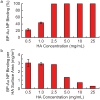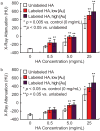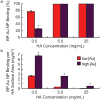Bisphosphonate-functionalized gold nanoparticles for contrast-enhanced X-ray detection of breast microcalcifications
- PMID: 24360718
- PMCID: PMC3956113
- DOI: 10.1016/j.biomaterials.2013.11.077
Bisphosphonate-functionalized gold nanoparticles for contrast-enhanced X-ray detection of breast microcalcifications
Abstract
Microcalcifications are one of the most common abnormalities detected by mammography for the diagnosis of breast cancer. However, the detection of microcalcifications and correct diagnosis of breast cancer are limited by the sensitivity and specificity of mammography. Therefore, the objective of this study was to investigate the potential of bisphosphonate-functionalized gold nanoparticles (BP-Au NPs) for contrast-enhanced radiographic detection of breast microcalcifications using two models of breast microcalcifications, which allowed for precise control over levels of hydroxyapatite (HA) mineral within a low attenuating matrix. First, an in vitro imaging phantom was prepared with varying concentrations of HA uniformly dispersed in an agarose hydrogel. The X-ray attenuation of HA-agarose compositions labeled by BP-Au NPs was increased by up to 26 HU compared to unlabeled compositions for HA concentrations ranging from 1 to 10 mg/mL. Second, an ex vivo tissue model was developed to more closely mimic the heterogeneity of breast tissue by injecting varying concentrations of HA in a Matrigel carrier into murine mammary glands. The X-ray attenuation of HA-Matrigel compositions labeled by BP-Au NPs was increased by up to 289 HU compared to unlabeled compositions for HA concentrations ranging from 0.5 to 25 mg/mL, which included an HA concentration (0.5 mg/mL) that was otherwise undetectable by micro-computed tomography. Cumulatively, both models demonstrated the ability of BP-Au NPs to enhance contrast for radiographic detection of microcalcifications, including at a clinically-relevant imaging resolution. Therefore, BP-Au NPs may have potential to improve clinical detection of breast microcalcifications by mammography.
Keywords: Breast cancer; Computed tomography; Contrast agent; Gold nanoparticles; Mammary gland; Microcalcification.
Copyright © 2013 Elsevier Ltd. All rights reserved.
Figures








Similar articles
-
Contrast-enhanced X-ray detection of breast microcalcifications in a murine model using targeted gold nanoparticles.ACS Nano. 2014 Jul 22;8(7):7486-96. doi: 10.1021/nn5027802. Epub 2014 Jul 11. ACS Nano. 2014. PMID: 24992365
-
Contrast-Enhanced X-ray Detection of Microcalcifications in Radiographically Dense Mammary Tissue Using Targeted Gold Nanoparticles.ACS Nano. 2015 Sep 22;9(9):8923-32. doi: 10.1021/acsnano.5b02749. Epub 2015 Aug 31. ACS Nano. 2015. PMID: 26308767
-
Effects of bisphosphonate ligands and PEGylation on targeted delivery of gold nanoparticles for contrast-enhanced radiographic detection of breast microcalcifications.Acta Biomater. 2018 Dec;82:122-132. doi: 10.1016/j.actbio.2018.10.014. Epub 2018 Oct 11. Acta Biomater. 2018. PMID: 30316022
-
Micro-CT Microcalcification Analysis: A Scoping Review of Current Applications and Future Potential in Breast Cancer Research.Tomography. 2024 Oct 24;10(11):1716-1729. doi: 10.3390/tomography10110126. Tomography. 2024. PMID: 39590935 Free PMC article.
-
Gold nanoparticle contrast agents in advanced X-ray imaging technologies.Molecules. 2013 May 17;18(5):5858-90. doi: 10.3390/molecules18055858. Molecules. 2013. PMID: 23685939 Free PMC article. Review.
Cited by
-
Diagnostic performance of ADCs in different ROIs for breast lesions.Int J Clin Exp Med. 2015 Aug 15;8(8):12096-104. eCollection 2015. Int J Clin Exp Med. 2015. PMID: 26550121 Free PMC article.
-
Drosophila melanogaster as a function-based high-throughput screening model for antinephrolithiasis agents in kidney stone patients.Dis Model Mech. 2018 Nov 16;11(11):dmm035873. doi: 10.1242/dmm.035873. Dis Model Mech. 2018. PMID: 30082495 Free PMC article.
-
Novel Methods of Determining Urinary Calculi Composition: Petrographic Thin Sectioning of Calculi and Nanoscale Flow Cytometry Urinalysis.Sci Rep. 2016 Jan 14;6:19328. doi: 10.1038/srep19328. Sci Rep. 2016. PMID: 26771074 Free PMC article.
-
New Progress in Improving the Delivery Methods of Bisphosphonates in the Treatment of Bone Tumors.Drug Des Devel Ther. 2021 Dec 10;15:4939-4959. doi: 10.2147/DDDT.S337925. eCollection 2021. Drug Des Devel Ther. 2021. PMID: 34916778 Free PMC article. Review.
-
Detection of microcalcifications using nonlinear beamforming techniques.Ultrasound Med Biol. 2023 Aug;49(8):1709-1718. doi: 10.1016/j.ultrasmedbio.2023.03.011. Epub 2023 Apr 30. Ultrasound Med Biol. 2023. PMID: 37127527 Free PMC article.
References
-
- Siegel R, Naishadham D, Jemal A. Cancer statistics, 2012. CA Cancer J Clin. 2012;62(1):10–29. - PubMed
-
- Tabar L, Fagerberg CJ, Gad A, Baldetorp L, Holmberg LH, Gröntoft O, Ljungquist U, Lundström B, Månson JC, Eklund G. Reduction in mortality from breast cancer after mass screening with mammography. Randomised trial from the Breast Cancer Screening Working Group of the Swedish National Board of Health and Welfare. Lancet. 1985;325(8433):829–832. - PubMed
-
- Tabar L, Vitak B, Chen THH, Yen AMF, Cohen A, Tot T, Chiu SYH, Chen SLS, Fann JCY, Rosell J, Fohlin H, Smith RA, Duffy SW. Swedish two-county trial: Impact of mammographic screening on breast cancer mortality during three decades. Radiology. 2011;260(3):658–663. - PubMed
-
- Leborgne R. Diagnosis of tumors of the breast by simple roentgenography; calcifications in carcinomas. Am J Roentgenol Radium Ther. 1951;65(1):1–11. - PubMed
-
- Morgan MP, Cooke MM, McCarthy GM. Microcalcifications associated with breast cancer: An epiphenomenon or biologically significant feature of selected tumors? J Mammary Gland Biol Neoplasia. 2005;10(2):181–187. - PubMed
Publication types
MeSH terms
Substances
Grants and funding
LinkOut - more resources
Full Text Sources
Other Literature Sources
Medical

